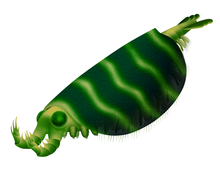Deuteropoda
| Deuteropoda | |
|---|---|

| |
| Life restoration of Kylinxia zhangi, a basal deuteropod | |

| |
| Life restoration of Surusicaris, a likely basal deuteropod | |
| Scientific classification | |
| Domain: | Eukaryota |
| Kingdom: | Animalia |
| Phylum: | Arthropoda |
| (unranked): | Deuteropoda Ortega-Hernández 2016[1] |
| Subphyla and classes | |
Deuteropoda or "upper stem group arthropods" is a proposed clade of arthropods whose members are distinguished by an anatomical reorganization of the head region, namely the appearance of a differentiated first appendage pair (the 'deutocerebral' pair), a multisegmented head, and a hypostome/labrum complex.[1]
The clade contains all living arthropods (i.e. chelicerates and mandibulates) as well as several fossil groups that share these characteristics (e.g. fuxianhuiids, megacheirans and Artiopoda), while excluding other fossil groups that are more 'basal' or 'primitive' (e.g. anomalocarids and lobopodians).[1][2]
Defining characteristics
Members of Deuteropoda are characterized by the presence of a differentiated labrum and a differentiated first 'deutocerebral' pair of appendages.[1] In contrast, lobopodians (part of the "lower stem group") and onychophorans have a pair of pre-ocular or 'protocerebral' appendages, which presumably have evolved to be the labrum of modern living arthropods.[2]
Phylogeny
The cladogram below is a simplified summary of the panarthropod phylogeny, taking into account the differentiation between "lower stem group arthropods" and "upper stem group arthropods" as well as two new fossils found to be the most early branches of Deuteropoda[3][4] (living groups are marked in bold).
| Panarthropoda | "lower stem group" "upper stem group" + crown group | |
References
- ^ a b c d Ortega-Hernández, Javier (2016), "Making sense of 'lower' and 'upper' stem-group Euarthropoda, with comments on the strict use of the name Arthropoda von Siebold, 1848", Biol. Rev., 91 (1): 255–273, doi:10.1111/brv.12168, PMID 25528950, S2CID 7751936
- ^ a b Budd, Graham E. (2021). "The origin and evolution of the euarthropod labrum". Arthropod Structure & Development. 62: 101048. doi:10.1016/j.asd.2021.101048. ISSN 1467-8039. PMID 33862532.
- ^ Zeng, Han; Zhao, Fangchen; Niu, Kecheng; Zhu, Maoyan; Huang, Diying (November 2020), "An early Cambrian euarthropod with radiodont-like raptorial appendages", Nature, 588 (7836): 101–105, Bibcode:2020Natur.588..101Z, doi:10.1038/s41586-020-2883-7, PMID 33149303, S2CID 226248177
- ^ O’Flynn, Robert; Williams, Mark; Yu, Mengxiao; Harvey, Thomas; Liu, Yu (2022), "A new euarthropod with large frontal appendages from the early Cambrian Chengjiang biota", Palaeontologia Electronica, 25 (1): a6, doi:10.26879/1167, S2CID 246779634






